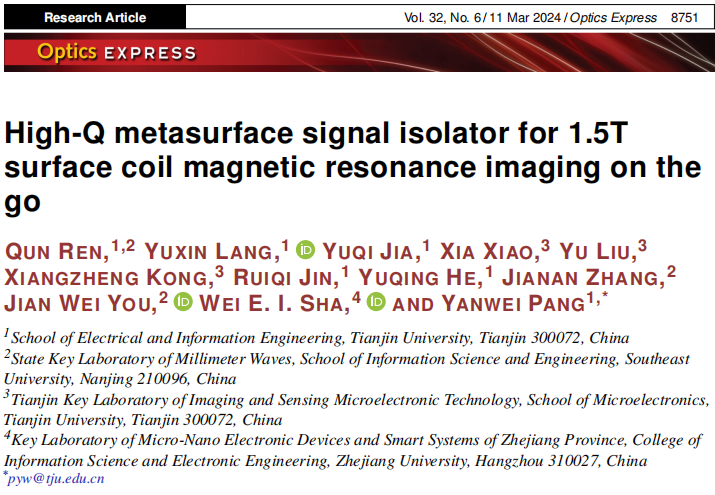
“The combination of surface coils and metamaterials significantly improves the performance of Magnetic Resonance Imaging (MRI), offering notable local enhancement flexibility. However, due to the coupling between the two, the signal-to-noise ratio (SNR) and low contrast resolution are hindered, further obstructing the future development of clinical MRI. This paper proposes a high-Q metasurface decoupling isolator, driven by a topological LC ring, designed for 1.5T surface coil MRI systems, enhancing the magnetic field by 5 times at 63.8 MHz. A polarization conversion mechanism is employed to effectively eliminate the coupling between MRI metamaterials and RF (radio frequency) surface transceivers. Additionally, high-Q resonance is achieved through the utilization of bound states in the continuum (BIC). This research paves a promising path for user-friendly and portable surface coil MRI scanners.”

Original Paper
Q. Ren, Y. Lang, Y. Jia, X. Xiao, Y. Liu, X. Kong, R. Jin, Y. He, J. Zhang, J. You, Wei E. I. Sha, and Y. Pang, “High-Q metasurface signal isolator for 1.5T surface coil magnetic resonance imaging on the go,” Optics Express 32, 8751-8762 (2024).
I. Background of Magnetic Resonance Imaging
MRI Evaluation Index
Magnetic Resonance Imaging (MRI) is widely used for the early diagnosis and screening of systemic tumors and neurological diseases due to its non-invasive and high-penetration characteristics. Among these, the signal-to-noise ratio (SNR) is one of the important metrics for evaluating image quality. A higher SNR implies better spatial resolution and faster imaging, which is key technology for promoting future clinical MRI examinations.
Application of Metamaterials
The unique properties of metamaterials arise from the inherent characteristics of their constituent materials and the precise arrangement of their internal structures, providing significant design flexibility. Numerous studies have demonstrated the potential of metamaterials to enhance the SNR of RF surface coils in MRI systems.
Joint Application of Metamaterials and Surface Coils
Pursuing local surface coil MRI is an attractive alternative to traditional birdcage coil transmission, particularly for patients with implants. It significantly enhances the magnetic field, expands the imaging range, and greatly improves the SNR.
Bottleneck Issues of Joint Application
There inevitably occurs a certain coupling interaction between the two, leading to reduced signal transmission efficiency, amplified noise, and unexpected safety concerns. In particular, an additional magnetic field inhomogeneity may introduce artifacts or even image failure.
Proposal of Isolator
In fact, balancing decoupling and MRI signal enhancement has become an important technical challenge. Achieving both goals simultaneously requires careful consideration and design to optimize system performance. This paper reports a decoupling isolator based on high-Q metasurfaces for magnetic resonance imaging, effectively eliminating this coupling through polarization conversion. Although various operational and magnetic field enhancement schemes have been proposed, we present a configuration of multilayer decoupling isolators and demonstrate its practicality and effectiveness for clinical applications. Additionally, we investigate the principle of cross-polarization conversion to elucidate the mechanism of the isolator when exposed to incident circularly polarized plane waves. Finally, the performance of the decoupling isolator is validated using wrist and leg imaging examples. During the MRI process, the resonance modes of the metamaterials are excited, resulting in a significant enhancement of the magnetic field.
II. Structure of the Isolator
1. Serpentine Metal Winding Structure
This paper designs a decoupling metasurface isolator excited by circularly polarized signals, consisting of three groups of winding arrays, as shown in Figure 1(a), with a length of 29.48mm, a width of 23.4 mm, and a height of 58 mm. The metal winding (=40.5mm, =36mm), connected with rectangular metal strips, realizes the cross-polarization transformation necessary for the decoupling process (dielectric layer material is FR-4, dielectric constant is 4.3, metal winding structure material is copper, conductivity is 5.8e+7 S/m).
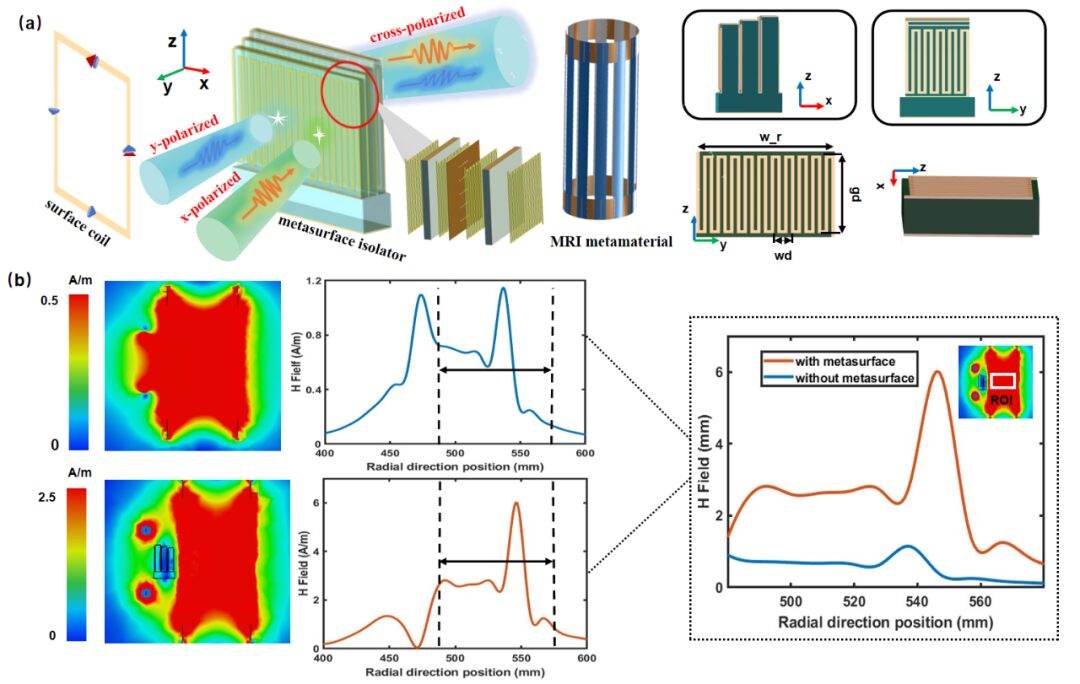
Figure 1 (a) Co-simulation diagram of the MRI enhancement system. The metasurface can be divided into three layers, including three dielectrics of different widths (42 mm, 40 mm, 38 mm), with metal windings on both sides, all placed at a distance of 1.7 mm. (b) Magnetic field enhancement and radial magnetic field intensity distribution spectrum with and without the metasurface isolator.
2. Magnetic Field Enhancement Effect
The magnetic field enhancement and the radial distribution of the magnetic field are illustrated as shown. In Figure 1(b), within the region of interest (ROI), particularly along the Z-coordinate radial distribution (a rectangular area is taken in the middle along the radial of the metamaterial to observe the uniformity of radial magnetic field enhancement). A side view of the magnetic field between the surface coil and the metamaterials indicates coupling between the two components, leading to an overall reduction in the magnetic field. While maintaining the distance between the metamaterials and the surface coil constant, when a decoupling metasurface isolator is placed in the middle, the magnetic field enhancement at 63.8 MHz can be significantly improved.
It is noteworthy that in the absence of the decoupling isolator, the magnetic field spectrum exhibits two peaks radially. However, when the decoupling isolator is introduced, the first peak disappears, leaving only a peak at 540mm. This occurs because, despite the decoupling isolator, there still exists a certain degree of coupling between the surface coil and the metamaterials themselves. As a result, the magnetic field strength near the isolator decreases (at 470 mm). Inside the metamaterials, as the radial distance increases, both curves consistently show the same trend, further confirming the decoupling effect achieved by the isolator.
III. Performance of the Isolator
1.Equivalent Topological LC Circuit of the Metasurface Isolator
To analyze the electromagnetic behavior of the metal-dielectric hybrid metamaterials, the overall structure can be decomposed into three cascaded layers, represented as “Part1”, “Part2”, and “Part3” in the equivalent circuit. Based on the structure of the metasurface isolator, an equivalent LC circuit model is established. The bottom layer consists of a metallic square patch coupled to the dielectric layer substrate. This layer not only reflects incident electromagnetic waves but also exhibits band-stop characteristics. Further windings in the dielectric layer and adjacent serpentine metal winding structures exhibit band-pass characteristics determined by their slot design, which can be represented as a parallel combination of inductors and capacitors. The serpentine metal structures sandwiched on both sides can be viewed as a series connection structure. Therefore, for a single-sided metal structure, connections are established between the two metal structures through upper and lower metal strips, forming a series circuit referred to as “Part1”, and so forth. The total three-layer cascaded corresponding circuit model is decomposed into series circuits of Part1, Part2, and Part3. In the absence of other metal layers, the bottom square metal patch is composed of metallic square patches that reflect incident electromagnetic waves, thus blocking the electromagnetic waves. The modeling is conducted through a series combination of inductors and capacitors to provide band-stop characteristics. The final specific calculation formula for the LC equivalent circuit meets the resonance requirements for a 1.5T magnetic field.
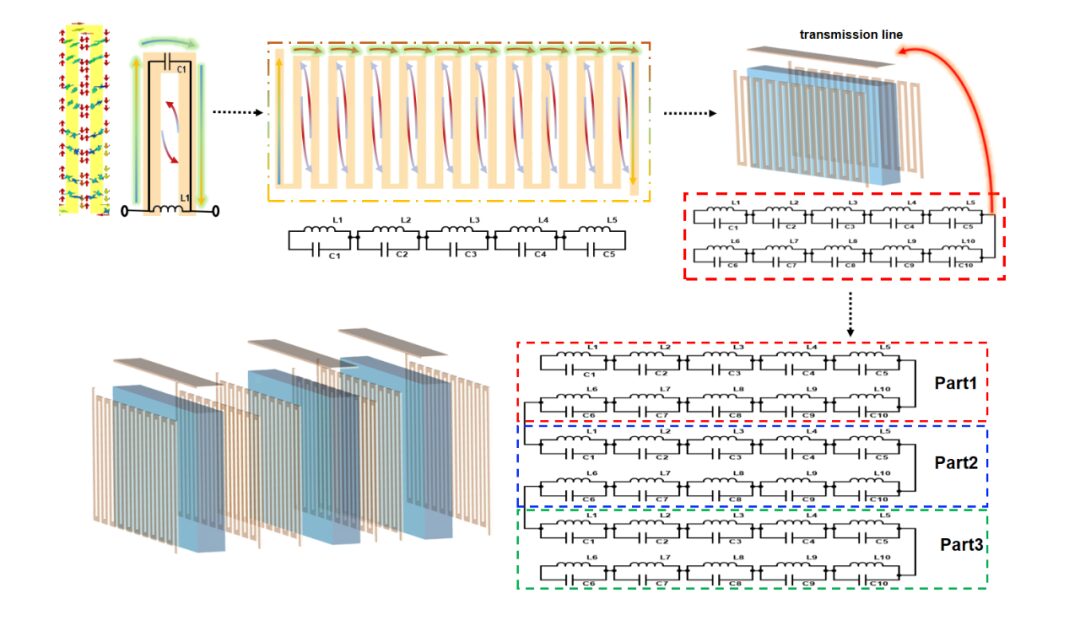
Figure 2 Derivation of the equivalent LC circuit schematic of the three-layer cascaded decoupling metasurface. The upper left, middle upper, and upper right corners depict the current distribution and circuit model of single winding structure, single-layer metal winding structure, and double-layer metal winding structure with added dielectric, respectively. Below is a decomposition diagram of the three-level cascaded structure and the corresponding circuit model.
2.Basic Physical Principles of the Decoupling Process
Incident x-polarized waves and y-polarized waves become orthogonal waves (y-polarized wave and x-polarized wave, respectively) after passing through the decoupling isolator, thereby reducing the coupling between the surface coil and the MRI metamaterials and superimposing the mode vectors of both. Based on the polarization conversion principle of the metasurface isolator, the electric field distribution of the metal winding structure during the conversion process of x-polarized and y-polarized waves is further analyzed.
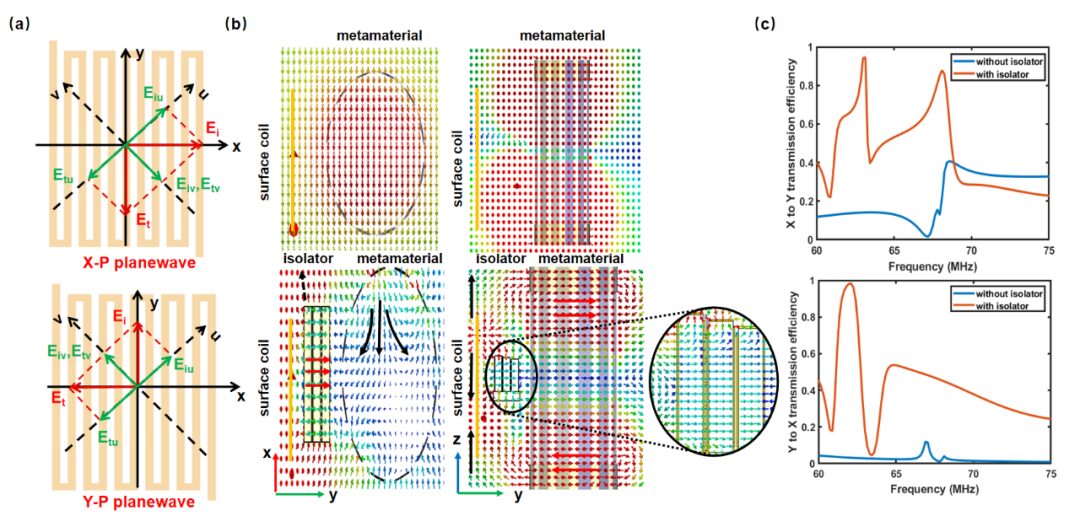
3. Achieving High Quality Factor
High Q factors are achieved by breaking the structural symmetry within the system, thus forming symmetry-protected BICs. When a state exhibits different symmetry characteristics compared to its surrounding environment, it decouples from radiation and manifests as BIC. This unique state is referred to as symmetry-protected BIC, which maintains its locality as long as the system symmetry remains unchanged. A significant feature of symmetry-protected BICs is their predictability, avoiding the need to finely tune structural parameters in wave vector space to locate them, extensively studied in various systems, including metasurfaces, subwavelength structures, classical gratings, and photonic crystals.
This paper introduces a metasurface that achieves high Q factor BICs in a cross-polarization configuration. Initially, under symmetrical conditions on both sides of the metal winding structure, no resonant peaks are observed in the spectral response. Subsequently, we break the symmetry of the structure by reducing the length of the leftmost metal strip, thus narrowing the length difference of the left and right metal strips
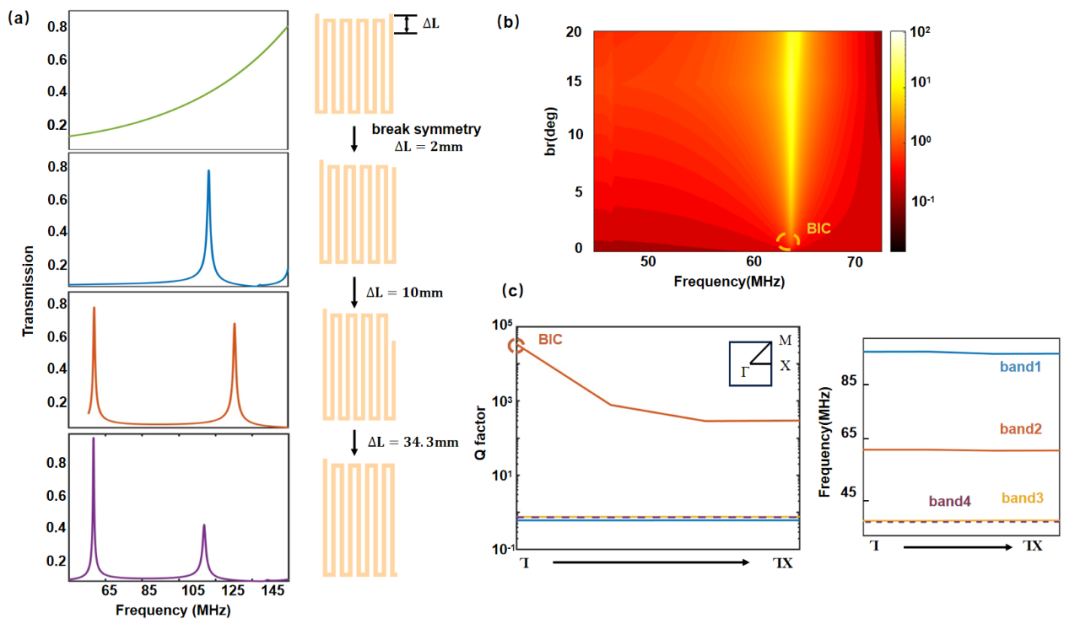
Figure 4(a) Transmission spectra at Δ𝐿= 0 mm, 2 mm, and 10 mm. (b) Discrete spectra and chromaticity diagrams of simulated transmission spectra at different Δ𝐿 and varying Δ𝐿. (c) Q factors corresponding to BIC and band structure.
IV. Conclusion
This paper provides an effective method for designing a high-Q metasurface decoupling isolator for 1.5T surface coil magnetic resonance imaging. The multilayer structure ensures a uniform field distribution and circular polarization conversion, eliminating the coupling between the surface coil and the metamaterials while utilizing BIC to achieve high Q values for high field MRI. The research findings of the decoupling isolator indicate its potential application in all clinical sequences, with enhanced SNR and resolution. The frequency shift issue in MRI imaging at 1.5T is expected to be automatically tuned by artificial intelligence in the future, providing a new direction for research on MRI in the field of artificial intelligence.
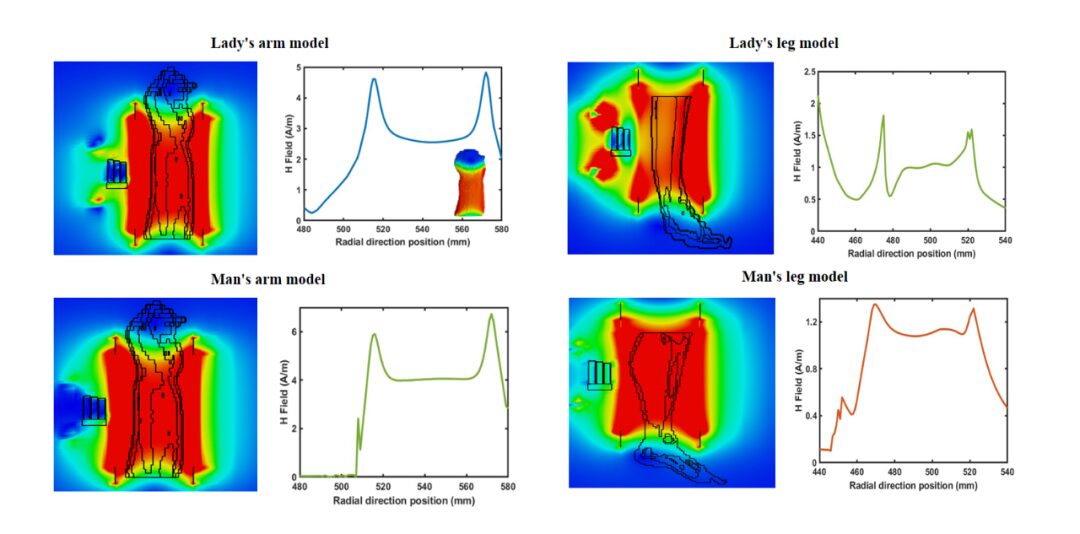
The end